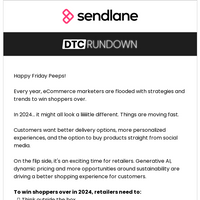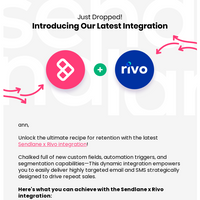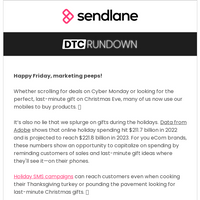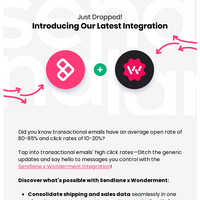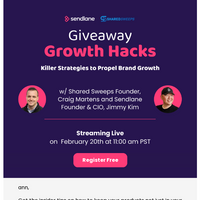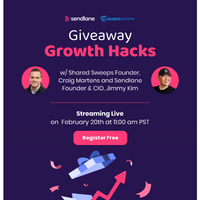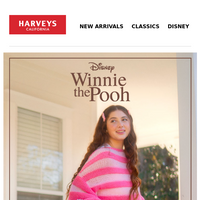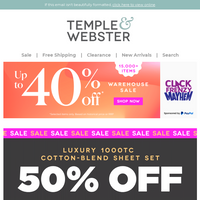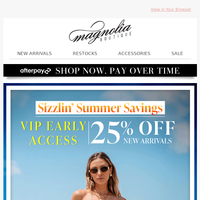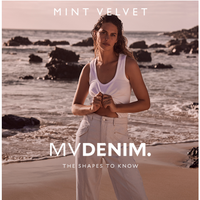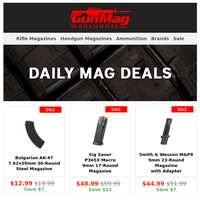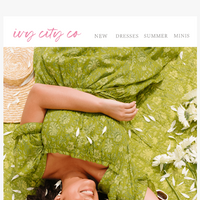Hey ann,
Let’s leave those outdated personalization strategies in 2005 where they belong!
To craft a stellar email and SMS marketing strategy, you need to master audience management from the get-go.
And where does it all start?Introducing: buyer personas!
The better you understand your contacts, the sharper your segmentation will be. And with targeted segmentation comes increased engagement and more purchases.
But before we dive into the details, we’ve got some exciting free content coming your way...
6 Essential Tools to Improve
eCommerce Retention & Loyalty
When the going gets tough, the tough gets retention—your secret weapon in those moments when the struggle gets real.
Our friends over at Triple Whale are hosting a free webinar next week onJune 27th @ 1 PM ET/ 10 AM PT all about restocking your retention arsenal with enough power to ride the wave.
And guess what? Our very own Jimmy Kim will be there to share expert insights that you won’t want to miss.
Secure your spot right here and join us for a session packed with valuable takeaways!
Your 300 Point Checklist to Optimize Your Online Store & Drive More Sales
Our friend Will Laurenson from Customers Who Click has crafted the ultimate checklist to turbocharge your conversions from that oh-so-precious traffic.
What’s inside you ask?
- A whopping 300-point checklist that’s generated millions in extra revenue for his clients
- 53 proven boosters to skyrocket your conversion rates
- 17 tested tweaks to ramp up your average order value
- The definitive toolkit Will swears by to supercharge online stores
(+ discounts)
Grab your copy right here and start boosting those conversions!
Now let’s get into the nitty-gritty of segmenting your audience based on buyer persona, step by step. 👣
How to Segment Emails Based on Buyer Persona: Step By Step

Why is it important to personalize emails based on buyer personas?
Abuyer personais a profile of your customers’ shared general characteristics—such as your customers’ gender, age, aspirations, and more.
If you serve multiple target audiences, you may have multiple buyer personas.
For example, if you sell plants, you might have a buyer persona of “Grandma Gina” who is 62 years old, female, and retired. She loves to garden every day and tend to her roses, however she wants to grow new plants but doesn’t know what else she could try growing.
You might also have another buyer persona for another target customer, “Green-Thumbed Thomas” who is 32 years old, male, and works full-time. He wants to keep house plants to add a sense of calm to his home but doesn’t have time to tend to his plants.
Seeing that these detailed buyer personas are very different, you need to approach both customer types uniquely if you want to earn their business! 💰
By sendingtailored email content to your customers, they’re more likely to spend time checking out your email and your products.
They might even place an order or two. Score! 🙌
What are the different types of segments?
Segmenting your email list according to separate buyer personas is one way to do it. However, you can also group your contacts based on specific characteristics found in your buyer personas.
Here are someessential segmentsyou should be using:
1. Demographic segmentation
In demographic segmentation, you’ll segment your contacts based on various demographic information, such as their:
👉
Age
👉
Gender
👉
Birth Month
For example, if you were segmenting your contacts by age, you could have a segment of contacts aged between 25 and 30.
If your demographic segments don’t provide sufficient insights for your marketing strategy—you can pair demographic segments with other traits to target your contacts more effectively.
2. Psychographic segmentation
Psychographic segmentation involves grouping your contacts by their psychological attributes, such as their personal values, beliefs, or outlook on life.
For instance, you might have a segment of contacts who are more environmentally conscious, and to whom you might market “greener” products such as reusable containers. ♻️

3. Geographical segmentation
This one is quite straightforward: you’ll segment your contacts based on their geographical location. 📍
These can be as broad as grouping contacts based on their country of residence or as narrow as grouping them based on their individual zip codes.
Segmenting your contacts geographically is useful for promoting offers and products that only apply within a certain area.
4. Behavioral segmentation
Leveraging yourcontacts' distinctive behaviors provides another powerful method for segmenting your audience.
Some ways you can segment your contacts by behavior:
👉
Product purchased
👉
Purchase frequency
👉
AOV (average order value)
5. Interest-based segmentation
As you interact with your contacts over time, you'll find that some of them have common interests.
For example, if you run an online bookstore, you could segment your contacts based on whether they prefer fiction or non-fiction books. As you dive deeper, you can also create sub-segments of interests and split these bookworms up into further segments based on their preferred genre, such as mystery books. 📚

If you aren’t sure what your contacts’ interests are, you can ask them by periodically surveying them to get their latest interests.
6. Engagement-based segmentation
How frequently do your contacts engage with your emails?
In other words, how often your contacts open and click the links in your emails can also provide a basis for segmenting them. You can segment contacts who haven’t engaged with your emails recently and send them an email designed to re-engage them.
Check out this example of such a re-engagement email, courtesy of men’s streetwear storeUrban Industry:

With luck, recipients of your re-engagement email will become active readers of your emails and shoppers of your business again.
If they remain unengaged, you can clean them out from your email database and stop sending future emails their way.
7. Lifecycle segmentation
Lifecycle segmentation is the practice ofsegmenting your contacts based on the stage they’re at in the customer lifecycle. 🔁
Here’s an overview of each stage of the customer lifecycle:
- Early: This stage is where potential customers may not be familiar with your products, so consider sending them welcome emails & other engaging content to pique their interest.
- Mid: These customers likely made at least one purchase with you (hooray!). Now, keep them engaged with cross-sell emails so you can maximize the amount of revenue earned from them.
- Late: Contacts in this stage have likely not purchased from you in the last 60 days or so. Try sending win-back emails with exclusive offers to persuade them to make a purchase again.
How to segment according to buyer persona
1. Identify your buyer personas
If you don’t already havebuyer personas for email segments, you’ll need to create these first. Start identifying your buyer persona by conducting research on your customers.
What are their demographics, interests, wants, and pain points? 🤔
Analyze data for patterns and trends of how your customers interact with your brand, such as your customers’ purchase histories, average order values, and their clicks.
Make a list of all these shared characteristics and create a buyer persona that provides a complete picture of your customer base.
2. Collect customer feedback
It’s also crucial to collect feedback on what they think of your brand and how they use your products.
Your feedback-oriented questions could be:
- What made you buy [name of item] over another item?
- How do you make use of [name of item they have purchased]?
- How would you rate your shopping experience with us?
The responses you get will help you understand your customers’ motivations for buying your products—and subsequently create interest-based segments.
You could also collect feedback using a more scalable method by creatingsurvey emails that you can mass-send to customers. 📧
Here is an example feedback email fromDeFeet:

3. Use the data and create segments
Now that you have your buyer personas dialed, use them to create segments in your email platform.
If you’re doing so in Sendlane, you can set up your segments by clicking the Audience icon in the left-hand menu bar, followed by Segments and + Segment.
Use the OR/AND conditions to include or exclude contacts with certain characteristics from your segments as you see fit.
This help article on segments will be a handy resource if you need more guidance on setting up segments in Sendlane.
4. Use tags
Tags are labels you can apply to contacts who have shown a certain behavior—such as clicking on a product in an email. 🏷️
A single contact can have multiple tags at any one time—such as a tag for “shoes” and another for “VIP customer.” But what if you wanted to create a group of all contacts who have the same tag?
That’s when you’d use your trusty segments.
For example, you could create a “VIP Customers” segment to group all contacts who have been tagged with “shoes” to let them know about an upcoming product drop.
Learn more about the differences between tags & segmentshere.

5. Multivariate testing
Think of multivariate testing as A/B testing, but on steroids.
This cool feature lets you create up to four split-test emails for testing different email campaign components, such as:
👉
Your subject line
👉
Preheader text
👉
Email body content
With Sendlane you can test up to 12 different variables at the same time, and select the percentage of recipients who will receive your split-test emails.
Using multivariate testing, you can identify email components that are most effective for a particular segment of contacts and then tailor subsequent emails to that segment moving forward.
6. Personalize your emails with segmentation
Now, it’s time to do the actualpersonalization of your emails using your audience segments!
Decide on the segment(s) of contacts you are targeting with your latest email, then suss out their particular characteristics from their buyer persona.
Afterward, strategize how you can craft your email to appeal to such characteristics.
By now you know there are many ways of segmenting an email audience. You can glean these characteristics from your contacts’ buyer personas, so get cracking on creating these if you haven’t already.
If you enjoyed this weeks issue of The DTC Rundown, forward to your friends!
Until next time! 👋
Caitlin
Head of Marketing, Sendlane
|
NL Creating custom audiences using buyer personas͏ ͏ ͏ ͏ ͏ ͏ ͏ ͏ ͏ ͏ ͏ ͏ ͏ ͏ ͏ ͏ ͏ ͏ ͏ ͏ ͏ ͏ ͏ ͏ ͏ ͏ ͏ ͏ ͏ ͏ ͏ ͏ ͏ ͏ ͏ ͏ ͏ ͏ ͏ ͏ ͏ ͏ ͏ ͏ ͏ ͏ ͏ ͏ ͏ ͏ ͏ ͏ ͏ ͏ ͏ ͏ ͏ ͏ ͏ ͏ ͏ ͏ ͏ ͏ ͏ ͏ ͏ ͏ ͏ ͏ ͏ ͏ ͏ ͏ ͏ ͏ ͏ ͏ ͏ ͏ ͏ ͏ ͏ ͏ ͏ ͏ ͏ ͏ ͏ ͏ ͏ ͏ ͏ ͏ ͏ ͏ ͏ ͏ ͏ ͏ ͏ ͏ ͏ ͏ ͏ ͏ ͏ ͏ ͏ ͏ ͏ ͏ ͏ ͏ ͏ ͏ ͏ ͏ ͏ ͏ ͏ ͏ ͏ ͏ ͏ ͏ ͏ ͏ ͏ ͏ ͏ ͏ ͏ ͏ ͏ ͏ ͏ ͏ ͏ ͏ ͏ ͏ ͏ ͏ ͏ ͏ ͏ ͏ ͏ ͏ ͏ ͏ ͏ ͏ Hey ann,Let’s leave those outdated personalization strategies in 2005 where they belong!To craft a stellar email and SMS marketing strategy, you need to master audience management from the get-go.And where does it all start?Introducing: buyer personas!The better you understand your contacts, the sharper your segmentation will be. And with targeted segmentation comes increased engagement and more purchases.But before we dive into the details, we’ve got some exciting free content coming your way...6 Essential Tools to ImproveeCommerce Retention & LoyaltyWhen the going gets tough, the tough gets retention—your secret weapon in those moments when the struggle gets real.Our friends over at Triple Whale are hosting a free webinar next week onJune 27th @ 1 PM ET/ 10 AM PT all about restocking your retention arsenal with enough power to ride the wave.And guess what? Our very own Jimmy Kim will be there to share expert insights that you won’t want to miss.Secure your spot right here and join us for a session packed with valuable takeaways! Your 300 Point Checklist to Optimize Your Online Store & Drive More SalesOur friend Will Laurenson from Customers Who Click has crafted the ultimate checklist to turbocharge your conversions from that oh-so-precious traffic. What’s inside you ask? A whopping 300-point checklist that’s generated millions in extra revenue for his clients53 proven boosters to skyrocket your conversion rates17 tested tweaks to ramp up your average order valueThe definitive toolkit Will swears by to supercharge online stores (+ discounts)Grab your copy right here and start boosting those conversions! Now let’s get into the nitty-gritty of segmenting your audience based on buyer persona, step by step. 👣How to Segment Emails Based on Buyer Persona: Step By Step Why is it important to personalize emails based on buyer personas? Abuyer personais a profile of your customers’ shared general characteristics—such as your customers’ gender, age, aspirations, and more.If you serve multiple target audiences, you may have multiple buyer personas.For example, if you sell plants, you might have a buyer persona of “Grandma Gina” who is 62 years old, female, and retired. She loves to garden every day and tend to her roses, however she wants to grow new plants but doesn’t know what else she could try growing.You might also have another buyer persona for another target customer, “Green-Thumbed Thomas” who is 32 years old, male, and works full-time. He wants to keep house plants to add a sense of calm to his home but doesn’t have time to tend to his plants.Seeing that these detailed buyer personas are very different, you need to approach both customer types uniquely if you want to earn their business! 💰By sendingtailored email content to your customers, they’re more likely to spend time checking out your email and your products.They might even place an order or two. Score! 🙌What are the different types of segments? Segmenting your email list according to separate buyer personas is one way to do it. However, you can also group your contacts based on specific characteristics found in your buyer personas.Here are someessential segmentsyou should be using:1. Demographic segmentationIn demographic segmentation, you’ll segment your contacts based on various demographic information, such as their:👉 Age👉 Gender👉 Birth MonthFor example, if you were segmenting your contacts by age, you could have a segment of contacts aged between 25 and 30.If your demographic segments don’t provide sufficient insights for your marketing strategy—you can pair demographic segments with other traits to target your contacts more effectively.2. Psychographic segmentationPsychographic segmentation involves grouping your contacts by their psychological attributes, such as their personal values, beliefs, or outlook on life.For instance, you might have a segment of contacts who are more environmentally conscious, and to whom you might market “greener” products such as reusable containers. ♻️3. Geographical segmentationThis one is quite straightforward: you’ll segment your contacts based on their geographical location. 📍These can be as broad as grouping contacts based on their country of residence or as narrow as grouping them based on their individual zip codes.Segmenting your contacts geographically is useful for promoting offers and products that only apply within a certain area.4. Behavioral segmentationLeveraging yourcontacts' distinctive behaviors provides another powerful method for segmenting your audience.Some ways you can segment your contacts by behavior:👉 Product purchased👉 Purchase frequency 👉 AOV (average order value)5. Interest-based segmentationAs you interact with your contacts over time, you'll find that some of them have common interests.For example, if you run an online bookstore, you could segment your contacts based on whether they prefer fiction or non-fiction books. As you dive deeper, you can also create sub-segments of interests and split these bookworms up into further segments based on their preferred genre, such as mystery books. 📚If you aren’t sure what your contacts’ interests are, you can ask them by periodically surveying them to get their latest interests.6. Engagement-based segmentationHow frequently do your contacts engage with your emails?In other words, how often your contacts open and click the links in your emails can also provide a basis for segmenting them. You can segment contacts who haven’t engaged with your emails recently and send them an email designed to re-engage them.Check out this example of such a re-engagement email, courtesy of men’s streetwear storeUrban Industry: With luck, recipients of your re-engagement email will become active readers of your emails and shoppers of your business again.If they remain unengaged, you can clean them out from your email database and stop sending future emails their way.7. Lifecycle segmentationLifecycle segmentation is the practice ofsegmenting your contacts based on the stage they’re at in the customer lifecycle. 🔁Here’s an overview of each stage of the customer lifecycle:Early: This stage is where potential customers may not be familiar with your products, so consider sending them welcome emails & other engaging content to pique their interest.Mid: These customers likely made at least one purchase with you (hooray!). Now, keep them engaged with cross-sell emails so you can maximize the amount of revenue earned from them.Late: Contacts in this stage have likely not purchased from you in the last 60 days or so. Try sending win-back emails with exclusive offers to persuade them to make a purchase again.How to segment according to buyer persona1. Identify your buyer personasIf you don’t already havebuyer personas for email segments, you’ll need to create these first. Start identifying your buyer persona by conducting research on your customers.What are their demographics, interests, wants, and pain points? 🤔Analyze data for patterns and trends of how your customers interact with your brand, such as your customers’ purchase histories, average order values, and their clicks.Make a list of all these shared characteristics and create a buyer persona that provides a complete picture of your customer base.2. Collect customer feedbackIt’s also crucial to collect feedback on what they think of your brand and how they use your products.Your feedback-oriented questions could be:What made you buy [name of item] over another item?How do you make use of [name of item they have purchased]?How would you rate your shopping experience with us?The responses you get will help you understand your customers’ motivations for buying your products—and subsequently create interest-based segments.You could also collect feedback using a more scalable method by creatingsurvey emails that you can mass-send to customers. 📧Here is an example feedback email fromDeFeet:3. Use the data and create segmentsNow that you have your buyer personas dialed, use them to create segments in your email platform.If you’re doing so in Sendlane, you can set up your segments by clicking the Audience icon in the left-hand menu bar, followed by Segments and + Segment.Use the OR/AND conditions to include or exclude contacts with certain characteristics from your segments as you see fit.This help article on segments will be a handy resource if you need more guidance on setting up segments in Sendlane.4. Use tagsTags are labels you can apply to contacts who have shown a certain behavior—such as clicking on a product in an email. 🏷️A single contact can have multiple tags at any one time—such as a tag for “shoes” and another for “VIP customer.” But what if you wanted to create a group of all contacts who have the same tag?That’s when you’d use your trusty segments.For example, you could create a “VIP Customers” segment to group all contacts who have been tagged with “shoes” to let them know about an upcoming product drop.Learn more about the differences between tags & segmentshere.5. Multivariate testingThink of multivariate testing as A/B testing, but on steroids.This cool feature lets you create up to four split-test emails for testing different email campaign components, such as: 👉Your subject line👉Preheader text👉Email body contentWith Sendlane you can test up to 12 different variables at the same time, and select the percentage of recipients who will receive your split-test emails.Using multivariate testing, you can identify email components that are most effective for a particular segment of contacts and then tailor subsequent emails to that segment moving forward.6. Personalize your emails with segmentationNow, it’s time to do the actualpersonalization of your emails using your audience segments!Decide on the segment(s) of contacts you are targeting with your latest email, then suss out their particular characteristics from their buyer persona.Afterward, strategize how you can craft your email to appeal to such characteristics. By now you know there are many ways of segmenting an email audience. You can glean these characteristics from your contacts’ buyer personas, so get cracking on creating these if you haven’t already.If you enjoyed this weeks issue of The DTC Rundown, forward to your friends!Until next time! 👋CaitlinHead of Marketing, Sendlane Terms & ConditionsSupportBlog Sendlane 2712 Loker Avenue West #1107, Carlsbad, CA, United States, 92010 To update or remove your contact information please Manage Your Subscription.



